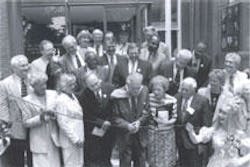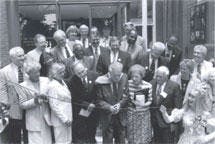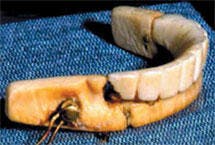The National Museum of Dentistry
The history and heritage of our profession attracts hundreds of visitors to Baltimore daily.
Foreword
I have always had tremendous pride in dentistry. As a third-generation dentist, I have enjoyed the heritage of our profession and the excellence in health care that we have brought to the public. I truly believe we have made a difference in the lives of hundreds of millions of people, and that dentistry is the fastest advancing field in health care today.
Every once in a while, an incredible event occurs that can make a difference for a large group of people. For dentistry, this event is the inception of the National Museum of Dentistry in Baltimore, Md. The museum is nothing like what you would expect. It is not a dull and uninteresting collection of antiquated equipment you may have seen stuck in some corner of your dental school years ago. Instead, it is an open, bright, incredible building with magnificent interactive exhibits, educational updates, and is visited daily by school children, adults, and others who want to know more about dentistry. It truly contains the history and heritage of our profession. A tour of the dental museum will literally knock you off your feet and significantly exceed any expectations you may have.
Despite the enormous pride I already have in our profession, I actually left the dental museum on my first and subsequent visit with an even greater depth of feeling for dentistry. As an former full-time practicing dentist and founder of a dental management-consulting firm, I have never felt so much pride as when I left the museum. It is almost impossible not to have a new recognition and renewal of excitement after you visit this incredible institution.
I was proud to be invited to write the foreword for this article that gives you a glimpse of this gem in Baltimore. I strongly recommend that you not only visit the museum during a trip to the Baltimore-Washington region, but that you find a way to become involved and make it a beneficiary of one of your annual charitable contributions. This will not only be good for the profession, but will elevate your pride in dentistry as never before.
Roger P. Levin
DDS, MBA
The National Museum of Dentistry
If someone mentioned "dental museum" to you, what images would come to mind? Probably things like:
- Ancient extractors and forceps used on patients before the invention of anesthesia
- A collection of rare and arcane dental books
- A foot-powered dental drill
- A few ancient, uncomfortable dental chairs
You certainly would not be surprised to find such artifacts at the Dr. Samuel D. Harris National Museum of Dentistry. What you might be surprised to find are entertaining exhibits like Plaque Attackers and Food For Thought. Located in a 1904 dental school building on the campus of the world's first dental college, the museum is a fully renovated building complete with state-of-the-art facilities where tens of thousands of school children, families, and tourists walk the halls each year. Fascinating exhibits detail the profession's advancement through the ages.
The National Museum of Dentistry (NMD), came into existence to raise awareness of the important role that oral health plays in overall health. Its permanent exhibition, 32 Terrific Teeth, showcases dentistry in popular culture, hygiene history, and the evolution of dentistry. NMD is more than a collection of dental instruments, though. The most prized artifact on exhibit is President George Washington's lower denture, carved from hippopotamus ivory and hinged with gold wire. Recently, a pair of forceps used to extract the first president's tooth was added to the Malott Gallery (supported by direct descendants of Dr. G.V. Black) where the famous denture is on display.
Much of NMD's success can be attributed to the individual donors, corporate sponsors, and founding benefactors whose support enables the museum to present engaging exhibitions and programs. "Smilestones," the museum's fifth anniversary gala hosted on June 23, recognized the accomplishments and successes of the past five years and detailed the direction the museum plans to take in the future.
Indeed, NMD had much to celebrate. One major triumph was the recent announcement that NMD is one of a select group of museums chosen as an affiliate of the Smithsonian Institution. Although NMD already houses several artifacts on short-term loan from the Smithsonian, including Dr. G.V. Black's office and several replicas of George Washington's dentures, this designation enables NMD to access collections for long-term loans, offer educational programming and expertise, and provide a forum to showcase NMD nationally.
One of the people acknowledged at the gala was Dr. Samuel Harris. Dr. Harris was an early proponent of a national museum of dentistry. In 1992, he gave a naming gift of a million dollars to establish NMD. His new gift will establish The Dr. Samuel D. Harris Endowment for Children's Dental Health Programs. The endowment will focus on educational programs that teach children — especially young children and the underserved — ways to maintain and improve their oral health.
Without a doubt, the emphasis on education is leading the NMD towards new enterprises. Not only are they working to raise oral health awareness for visitors, they're branching out to other museums across the nation. The newest exhibition, Branches, Bristles, and Batteries: Toothbrushes Through Time, is designed to travel nationally from September 2002 through July 2005. Currently on exhibit in the Saccente gallery, it reveals the evolution of the toothbrush from ancient Egyptian tooth sticks to today's state-of-the-art electronic models. "Brushella the Toothfairy" guides visitors along a timeline, tracing the modern toothbrush to its Mesopotamian roots, juxtaposing toothbrush innovations against historical events. The exhibition also features two interactive stations, Plaque Attackers and Food for Thought.
At the first interactive station, Food For Thought, children learn which foods are tooth-friendly and which lead to tooth decay by placing an oversized molar on a variety of different snacks. When the tooth lights up pearly white, they know they picked the tooth-healthy snack.
Children also must learn how to properly brush their teeth. Using an extra-large manual toothbrush, children brush the plaque off the teeth in an oversized mouth at the Plaque Attackers interactive station. It helps them to understand the proper way to brush their teeth and encourages them to brush each tooth carefully.
The museum's board of visitors is an outstanding group of professional and community leaders who advise and support the museum in achieving its vision. With their help, NMD also specializes in programs promoting oral health. MouthPower is a national five-year tobacco use prevention and oral cancer awareness program for Girl Scouts. Working with a task force made up of Girl Scout organizers, government representatives, museum board of visitors members, marketing professionals, and museum staff, NMD will target 130,000 Brownies and Junior Girl Scouts this year in the Delmarva region, encompassing four councils located in Washington, D.C., Delaware, Virginia, and central Maryland.
In this special interactive program, the girls will not only learn about dentistry, but also oral health, cigarette smoking and tobacco use prevention, symptoms of oral cancer, sensitivity to national tobacco advertisements, resistance to peer pressure, and character and self-esteem building skills. Oral Health America is providing the initial funding for the MouthPower program.
NMD plans to launch more technology into exhibitions in the near future. The museum recently introduced an audio tour that presents visitors with behind-the-scenes information and additional background on many artifacts within the galleries. Visitors can learn more about how NMD was able to obtain and rebuild the denture-holding Justi Cabinet in 32 Terrific Teeth, for example. In addition, NMD is planning to redesign the Crest Learning Hall by developing interactive CD-ROMs for the learning stations.
In fact, there is always something new to see in the museum's galleries. NMD explores many oral health topics and plans programs and exhibitions around those topics to engage family audiences. For example, last year, an exhibition highlighting facial protection as well as famous athletes who became dentists upon retirement filled the Saccente gallery. Watch Your Mouth! Sports and Dentistry received national coverage in ADA News, Dentistry Today, and several state dental society newsletters. Other temporary exhibitions include Women in Dentistry, Out of the Horses Mouth: Veterinary Dentistry, and Terrific Tooth Tales. Beginning in May 2002, NMD will exhibit African Americans in Dentistry, showcasing, for example, a replica of Charles Edwin Bentley's office circa 1920. NMD also plans to feature an important exhibition on dental specialties from 2003 to 2005 called The Great American Smile: The Role of the Dental Specialist. The staff is researching the history of each specialty and assembling a task force of experts to advise on the development of this major project.
Through its Web site — www.dentalmuseum.org — NMD is able to extend its reach to a global level. The site receives nearly 500 national and international visitors daily and features such attributes as the Museum Shop, volunteer opportunities, exhibition information and highlights, and donor recognition. Plans are under development to list NMD's expansive library collection online to facilitate historical dental research.
NMD is reaching a national and international audience in many ways.The museum's national advisory committee is made up of at least one representative from every state as well as the District of Columbia, Puerto Rico, and the U.S. Virgin Islands. The committee helps with the museum's phonathon, promotes their respective state's participation in the Wall of States, and promotes NMD at home. Twenty states currently participate in the Wall of States program, which signifies a gift equaling $1.50 per member from the state's dental association. A special plaque in the museum's foyer aknowledges each state. States are also listed on NMD's Web site, with a link between the state's association and NMD.
The five-year anniversary celebration was a wonderful opportunity to thank the museum's many donors, sponsors, and benefactors. Dr. Robert M. Anderton, president of the ADA and an honored guest at the gala, congratulated the museum on its achievements and was presented with a new NMD poster. Several museum board of visitors members spoke at the gala, including Dr. Richard Shaffer, Rear Admiral, Dental Corps U.S. Navy (retired), Dr. Jack Gottschalk, chair emeritus, and Dr. John Patterson, chair. Many leaders of the dental community attended the event, sponsored by Dentsply International, Henry Schein, Inc., MBNA America Bank, Crest, Oral-B Laboratories, and the Levin Group, Inc. A newly released 10-minute video produced by Ivey Production Company and narrated by Dr. Linda Niessen highlighted many of the people who have contributed to the success of the National Museum of Dentistry.
In five successful years, NMD has become the premier national museum dedicated to dental history, dentistry, and oral health. The museum needs support, however, from the entire dental community to continue to grow and prosper. NMD is a place of education, and a place that brings a better understanding of dentistry to the public. Any visitor will enjoy an exciting, unique, and valuable experience. We hope your imagination and curiosity will be piqued enough to visit the next time you find yourself in Baltimore. Even if you are not planning a trip soon, go online to www.dentalmuseum.org to see the museum's latest developments and information, or call (410) 706-0600. With continued support, this "crown jewel" of dentistry will bring pride to the dental profession.



